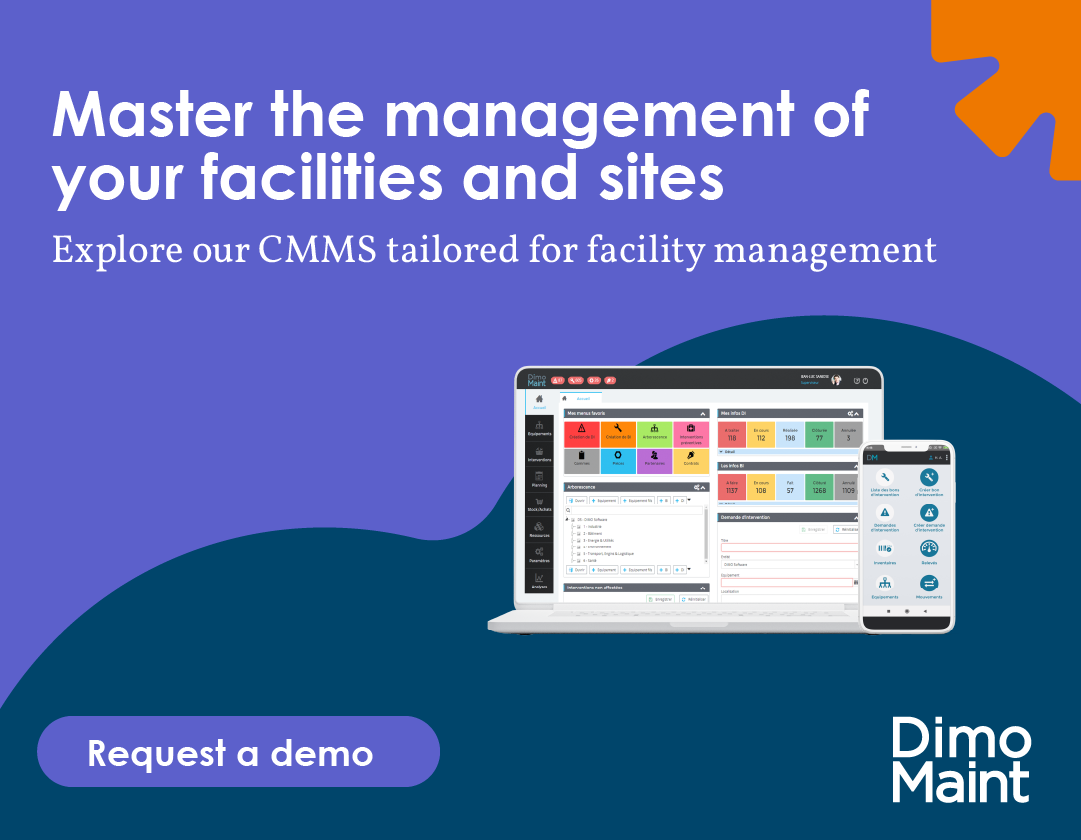In a town hall, a gymnasium or a school, a failure can quickly become more than a mere inconvenience. It can jeopardize a public service, generate extra costs and harm citizens’ perception of quality.
Yet, technical departments of local authorities often still operate reactively, based on informal alerts, scattered Excel files, or fragile collective memory. In a context of budgetary constraints, growing regulatory demands and pressure for greater performance, the CMMS establishes itself as a strategic lever.
A CMMS designed for the realities of the public sector enables local authorities to move from reactive maintenance to proactive, centralized, data-driven management.
Maintenance is a discreet but strategic pillar for local authorities
Each public building, town hall, school, gymnasium, media library is both a place of service and a symbol. Its physical condition affects the perception of the public service as much as the quality of welcome. Behind this façade, wear and tear operate: thermal cycles, humidity, heavy use, aging of technical installations.
Identifying early signs of deterioration—cracks, consumption drifts, minor malfunctions—helps avoid costly damage and interruptions to activity.
Major rehabilitation works are visible, but daily maintenance shapes the real durability of the estate. Operating and maintenance costs make up a decisive share of a building’s total cost, requiring structured management and adapted engineering to prevent budgetary drift.
Maintenance is therefore an invisible but essential investment: one euro invested early often prevents five euros spent in emergency.
Technical services embody the continuity of public service. As true internal project owners, they schedule maintenance, manage contractors, ensure regulatory compliance (fire safety, accessibility, hygiene) and guarantee user safety. In constrained organizations, their strategic role grows: they become the quiet architects of territorial performance.
The 3 key challenges facing local authorities’ technical services
-
Justify the value of every euro spent
With increasingly limited budgetary room, elected officials expect technical services to provide proof of the value created: costs avoided, energy savings, prioritization of investments.
A CMMS makes it possible to :
- Consolidate costs by asset, building or intervention
- Support decision-making with key indicators (cost/m², availability rate, number of avoided interventions)
- Produce clear, visual reports for management or elected officials.
-
Turn regulatory compliance into a routine, not a burden
Accessibility, fire safety, air quality, safety registers: obligations are numerous, especially in ERPs. Yet they are often handled in an ad hoc manner.
With the CMMS such as DimoMaint FM :
- Periodic checks are scheduled automatically ;
- Traceability is ensured: who intervened, when, on what ;
- Regulatory documents are centralized and accessible at any time.
-
Manage a multi-site estate efficiently
Between schools, town halls, technical centers, cultural buildings… a local authority’s building portfolio can become difficult to track.
A building CMMS makes it possible to :
- Structure a clear asset hierarchy (sites > buildings > assets)
- Centralize information in a single repository
- Provide a mobile app for staff to work efficiently in the field.
What a building CMMS like DimoMaint FM enables in practice
Centralize the asset knowledge base
For a long time, knowledge of the estate relied on spreadsheets and individual memories. The CMMS (Computerized Maintenance Management System) DimoMaint FM puts an end to that fragility and makes it possible to:
- Create a shared, evolving knowledge base
- Attach photos, plans, histories, manuals to each asset
- Integrate BIM data or IoT for connected buildings.
This living collective memory secures knowledge transfer, eases planning and provides immediate visibility on the state of the estate.
Schedule preventive and regulatory work
A well-configured CMMS brings together the entire maintenance cycle.
- Preventive, regulatory or corrective maintenance: everything is scheduled in a single tool
- Technicians receive their work orders on mobile (even offline)
- Work requests can be submitted by users via a simple portal.
This unification smooths daily work for staff and turns maintenance into a managed activity: emergencies decrease, visibility increases, decision-making becomes evidence-based.
Track every action to improve management
Each intervention is recorded: date, technician, duration, parts replaced, before/after photos. This level of traceability :
- Provides confidence during audits
- Serves as evidence for elected officials
- Gives legitimacy to technical decisions.
Being able to show and not just state what was done, what it cost and what it helped avoid gives maintenance a strategic role in local governance.
Analyze to make better decisions
Thanks to integrated dashboards :
- You track asset availability, costs per site
- You manage your contractors (timelines, quality, cost) via a collaborative portal
- You build a multi-year works plan based on real data.
How to build an “architectured” maintenance?
Here are some best practices that a building CMMS facilitates:
- Structure the asset register: inventories, asset records, contracts and histories integrated into the CMMS.
- Plan regulatory compliance as an integrated routine, with automatic reminders and digital archiving.
- Prioritize by criticality, combining impact and probability, while reserving capacity for unforeseen events.
- Make budgets objective: cost per m², avoided costs, measurable energy savings.
- Formalize a multi-year works plan, revised annually using real data.
By combining domain expertise, digital tools and data-driven management, local authorities can make maintenance a lever for overall performance.
With a building CMMS like DimoMaint FM, they :
- Secure their regulatory obligations
- Optimize long-term costs
- Give technical teams the means to act effectively
- Strengthen the transparency and credibility of their management.





